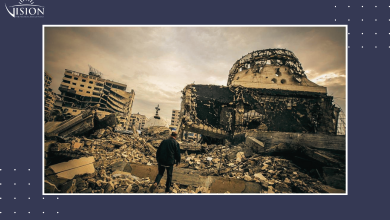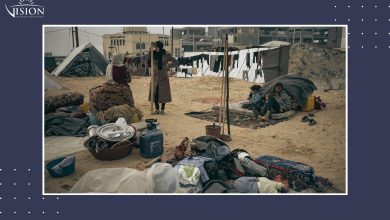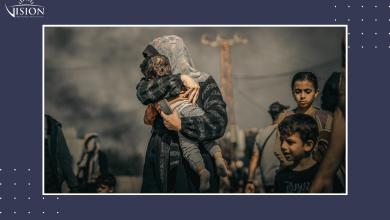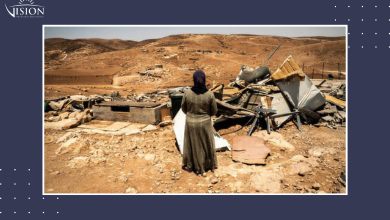Israeli Complex Options in the Gaza Strip

by Kareem Qart
The state of occupation declared a war on the Palestinians, setting a major goal for itself, namely “the elimination of Hamas.” However, it was evident from the beginning that the occupiers lacked a clear concept of how to achieve this objective. Indeed, doubts about its feasibility were apparent. Former Israeli Prime Minister Ehud Barak best articulated these doubts, stating in an interview that completely eradicating Hamas is impossible because it is an “ideological movement, existing in people’s dreams, hearts, and minds.” This perspective is not exclusive to Barak; it can be argued that the Israeli government and its experts are cognizant of this reality.
From here, it becomes apparent to the occupation that the problem is not Hamas, but rather the Gaza Strip itself, with its population exceeding 2.2 million citizens. This realization sparked a debate about “the day after” Hamas’s elimination. The United States initiated this discussion when President Joe Biden, during his visit to Israel and meeting with the Israeli security cabinet on October 18, posed challenging questions to the Israeli leaders. Biden reportedly urged the Israeli leaders to “start thinking about what happens the day after. How do you see the situation one month, two months, or a year from now – you have all the legitimacy and time to fight – but what happens the next day?” This American endeavor to devise a plan for Gaza’s future followed after the U.S. and Israel recognized the widespread Arab rejection of the idea of relocating Gaza’s population to Sinai or elsewhere.
This issue raises numerous questions about the alternatives proposed by Israel, fully supported by the U.S., to resolve the “Gaza problem,” as well as the obstacles these alternatives face. What is the approach currently being implemented by Israel on the ground? Despite the Israeli commitment to the option of forced displacement as a final solution to what it perceives as a perennial problem to its “security” and the entire “Zionist project,” this approach is being executed on the ground without an official declaration of its adoption, acknowledging the Arab, specifically Egyptian and Jordanian, opposition and the significant risks entailed by this option.
Professor Michael Milstein, a Zionist Orientalist who served as an advisor to the “Coordinator” between 2015-2018 and a researcher at the Moshe Dayan Center specializing in the study of the Arab and Islamic world, published an article in the Israeli newspaper “Yedioth Ahronoth” on October 17 titled “Who Will Govern Gaza? These are the Options, and All are Bad”. He was among the first from the occupation’s leadership and experts to address this matter, leveraging his Orientalist expertise formed around Palestinian society.
Milstein began his article by questioning the feasibility of eradicating Hamas. However, in case the Israelissucceed in this endeavor, an uncertain outcome, it will face four options for Gaza’s future: two advantageousand two hard. The most detrimental options, which must be avoided, according to him are:
- Re-occupying the Gaza Strip and maintaining Israeli rule. This option would have a high cost in terms of security, economy, and politics, similar to the experiences of the United States in Iraq and Afghanistan.
- Eliminating Hamas’s rule and quickly exiting Gaza, leaving behind a vacuum that would rapidly devolve into dangerous chaos.
The two good options include:
- Restoring the Palestinian Authority’s control over Gaza. However, this requires the Israeli government to abandon the notion that the Palestinian Authority is a worse enemy than Hamas. Furthermore, it seems unlikely that the Palestinian Authority, already struggling to administer the West Bank, would be interested in undertaking this complex task. Even if the PA accepted this role, perhaps backed by Israeli military support, it is uncertain how long it would effectively last.
- Developing an alternative governance to Gaza based on local leadership (mayors, dignitaries, tribal leaders), with the participation of the Palestinian Authority and external support from Egypt.
Although Milstein prefers the last option as the least detrimental, he also expresses skepticism about its feasibility. From the onset, it was clear that the options available to the state of occupation for Gaza’s future were few and challenging, even impossible to achieve.
The Displacement Option:
The first strategy pursued by the occupying state, with complete support from The US and the Westerncountries, was the displacement of Gaza’s population to Sinai. However, evacuating the residents would inevitably mean their non-return, aligning with the occupation’s ultimate goal.
There is no official Israeli or Western statement of displacing Palestinians from Gaza to Sinai. However, there have been numerous unofficial statements and calls from extremist officials advocating for the displacement of Gazans. For instance, Israeli Minister Avi Dichter described the migration of Palestinians from the north to the south of the Gaza Strip as the “Nakba of 2023.”
Since the beginning of the war, certain Israeli and American circles began advocating for “safe humanitarian corridors” to Sinai to isolate Palestinian civilians from the impacts of war. Additionally, the financial support plan for Ukraine and Israel presented by U.S. President Biden to Congress included a clause worth $3.495 billion under the title “Migration and Refugee Assistance.” This ambiguous term coincided with American efforts to persuade Arab countries to support the displacement of Gaza’s inhabitants.
The strong public opposition from several Arab countries, especially Egypt and Jordan, indicates the pressure they faced to accept the idea of displacement. Notably, Egypt which affirmed that Egyptian national security is a red line, signifying that the displacement plan can make up a strategic threat. Similarly, Jordan issued consecutive statements clarifying that displacing Palestinians, whether in Gaza or the West Bank, would be considered a declaration of war against Jordan.
Multiple Rejected Alternatives:
Following the explicit Arab rejection of the displacement plan, the United States, through its President who visited Israel and met with its security cabinet on October 17, called on the occupation to consider the day after. Since then, several plans for Gaza’s future have been proposed, all of which have failed and received no Arab consensus. These plans included returning the Palestinian Authority to administer Gaza, handing it over to Egyptian administration, transferring it to a joint Arab international administration, assigning it to NATO and United Nations forces, or reinstating Israeli occupation.
All American and Israeli projects regarding Gaza’s future were rejected regionally and specifically by Egypt and Jordan, as they would be most affected by any scenarios the occupation attempts to impose in Gaza. It was reported that el-Sisi clarified to CIA Director William Burns during his visit to Cairo on November 7, what can be termed as Egypt’s four ‘Nos’:
rejection of the displacement of Gaza’s inhabitants, refusal of Israel’s reoccupation and administration of Gaza, opposition to the proposal of Egyptian administration of the area, and rejection of NATO forces or any other foreign troops there.
With this Arab and regional refusal, the United States gradually retreated from its various proposals to find an exit for the state of occupation from the Gaza quagmire. During his attendance at the G7 summit in Tokyo, Blinken presented what is described as the five ‘nos’: no to the forced displacement of Palestinians from Gaza, no to using Gaza as a terrorism platform, no to reoccupying Gaza post-conflict, no to besieging Gaza, and no to reducing Gaza’s territory.
However, it does not appear that Israel has complied with these American cautions. The Israeli Prime Minister declared his opposition to the return of the Palestinian Authority to govern Gaza, stating: “We will not accept the return of a regime that teaches its children to kill Jews and hate them, funds terrorists, and did not condemn the atrocities on October 7.” He also insisted on retaining security control over Gaza, including “the ability of the Israeli army to enter the region at will to eliminate potential terrorists,” while simultaneously opposing the idea of handing over the region to international forces.
Netanyahu has reaffirmed his position regarding the Palestinian Authority and the occupation of Gaza in the conference he held with Benny Gantz and Yoav Gallant on November 18th. He concluded by saying: ‘I will not agree to any entity that pays money to terrorists, their families, and those who raise children to kill Jews and eliminate the state of Israel to enter Gaza. Without such a transformation in the nature of the civil administration present in Gaza, it’s just a matter of time before Gaza returns to terrorism, and I will not accept that.’ He refers here to the Palestinian Authority, which is perceived by settlers as another face of Hamas. Netanyahu added regarding the continued occupation control over Gaza: ‘Another condition I set for the day after is that the Defense Forces will have complete freedom to act in the Gaza Strip against any threat. Only in this way can we ensure the disarmament of Gaza.’
Despite American opposition to these Israeli attitudes, and the American affirmation of a ‘Palestinian leadership and a unification of Gaza with the West Bank under the Palestinian Authority,’ there is ambiguity in these positions. Blinken pointed to the need for a ‘transitional period’ at the end of the war, and that the occupying state will take over the comprehensive security responsibility in Gaza for an unspecified period.
These statements are highly ambiguous and maneuvering. In any case, there does not seem to be a significant difference in views between the occupying state and the United States regarding the future of the Gaza Strip.
Major Obstacles:
It was clear from the beginning that all the proposed alternatives are impractical, as ‘Milstein’ clarified before starting to propose these alternatives. However, the intense handling of the ‘Israeli’ and American plans during the days of the war raises many questions.
There are obstacles to implementing any of these alternatives, including:
- Arab and regional opposition to most of these plans, which is very important, as the implementation of several of them requires Arab approval and participation.
- The weakness of the Palestinian Authority, the erosion of its legitimacy, its inability to manage the West Bank, in addition to the clear ‘Israeli’ efforts to marginalize and weaken it, and confine it to a specific functional role.
- The possibility of opening new war fronts, especially from Hezbollah, whose Secretary-General Hassan Nasrallah confirmed that he would not allow the defeat of the Palestinian resistance, specifically Hamas.
- The most influential factor is that the resistance is still resisting. It is clear that it is far from military defeat. In contrast, the occupation army has not been able to occupy the Gaza Strip or even its north. Its progress is very slow, and the areas of its advancement are areas of escalating confrontation, not areas of occupation and control.
Given these very difficult obstacles, talk of a phase ‘after Hamas’ or ‘the next day’ seems far from reality and unlikely to occur unless the opposite occurs. In light of this, Netanyahu said: ‘We will not talk about the future of Gaza until after the elimination of Hamas.”
Conclusion:
The occupation faces a predicament regarding its approach to the Gaza Strip. While the resolution of this dilemma is seemingly straightforward — conceding to the minimum Palestinian national rights by establishing a fully sovereign Palestinian state within the 1967 borders — the occupation has entirely disregarded this solution, thereby nullifying its feasibility. Currently, the United States is searching for an escape for the occupation from its predicament and the limited options available in handling the Gaza Strip. Notably, the West Bank appears to be excluded from these considerations, despite the fact that the occupation’s dilemma encompasses not only Gaza but also the West Bank and Jerusalem.
Amid discussions of American and Israeli strategies for the post-war phase, the occupation is actively shaping the future of both Gaza and the West Bank. This involves working on the ground to foster conditions conducive to displacement, cloaked under the term ‘voluntary migration.’ This process involves the psychological manipulation and intimidation of the Palestinian people, coercing them into acquiescing to the Zionist agenda of annihilation and destruction, thereby rendering them more amenable to the notion of departing from their land, now rendered uninhabitable.
Nevertheless, it is not inevitable that the occupation will succeed in this venture. The same obstacles that impeded all previously proposed alternatives, including displacement, confront this unpublicized choice as well. Everything hinges on the war’s outcomes and the extent to which the occupying state is willing to risk escalating confrontations with other fronts and Arab nations. However, this situation also necessitates taking a stand against this scheme and implementing measures to halt the systematic killing and destruction aimed at the eradication and displacement of the Palestinian people.”





